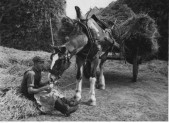Agriculture was a prominent use of land until the unearthing of coal, nowadays, agriculture has reverted to being the most common land use. As mining methods improved, coal was extracted from the surrounding seams around the village. The village changed in size and character and many new houses were built. The Miners Welfare Institute was […]
Schools in Ormiston
In 1842, there were three schools within the Parish, one in the village, one at Peaston and one at the House of Muir. In 1845, there were no children between 6 and 15 years of age that could not read and write and most over the age of 15 could read but not all could […]
Historic Population of Ormiston
The population was around 550 in 1649, 863 in 1790, 766 in 1801, 727 in 1811, 779 in 1821 and, 838 in 1831.
People in the History of Ormiston
In 1127, Robert; Bishop of St. Andrews, claimed that “all the churches of the whole of Lothian in common owe obedience to the Bishop of St. Andrews,” and among those present on the occasion of this declaration was Orm, Priest of Houm (Hume). Orme was a well known name in Scotland being borne by people […]
The Meaning of Ormiston
The word Ormiston is derived from a Scandinavian settler called ‘Orm’. With the family ‘Orme’ having possession during the twelve and thirteenth centuries, hence the name of Ormiston. Ormiston or ‘Ormistoun’ as it was called formerly is not an uncommon surname. The latter part of the name is formally spelt ‘toun’ is likely to descend […]
The Locality and Topography of Ormiston Parish
The Parish of Ormiston is bounded by Humbie to the South, Pencaitland on the East, Tranent on the North and Cranston on the West. It is about 5 miles in length and very irregular in breadth, varying from 1.5 to about 0.5 mile; its narrowest part being on the Eastern extremity and it is broadest […]
New Winton
From the eastern part of the village of Pencaitland a road leads off towards Tranent, passing the edge of the Winton estate to the left and the Bogg’s Holdings and Winton Hill farm on the right the road continues on, under the cropped railway bridge on into New Winton. Beyond New Winton is the peat-mire […]
Wolfstar
Originally the name appears to have been Ulfstruther signifying the Wolf’s Covert or hiding place. Other forms of the name are Foulstruther and Woolstruther. “de firmis duarum parcium Ville de Elphinstoun et Ulstruther, in warda ut supra” (Exchequer Rolls Volume IV) of also how in 1438 there is payment of £19, 13 shillings and 4d […]
Spilmersford
Heading south from the crossroads of the main road heading towards Saltoun, you pass the well kept New Cemetery and a quarter mile further stood the ruins of the hamlet of Spilmersford. Carboniferous limestone was long ago burned at Spilmersford. The deep excavations there now filled with water as well as the tumbled down kilns […]
Pencaitland House
Almost opposite the church and standing a short distance to the north of the road is the building known as Pencaitland House. The original old Pencaitland house, a 17th century building was destroyed by fire in 1875. Only two wings of the house survived and stand about 100 metres of Pencaitland Bridge within the policies […]


Recent Comments